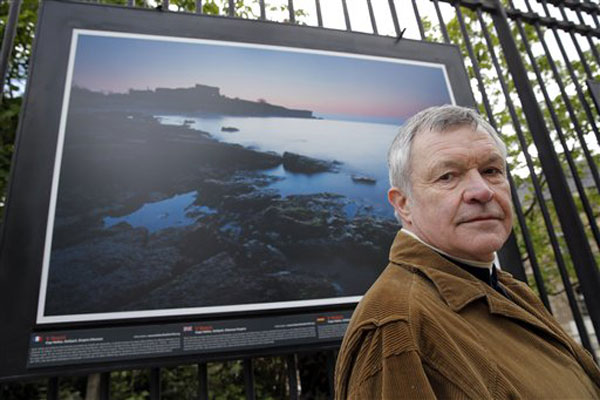Two Paris exhibits shed light on First World War

British photographer Michael St Maur Sheil poses in front of one of his pictures displayed at the Paris Luxembourg gardens, Tuesday, April 8, 2014, as part of an exhibition ” Fields of Battle – Lands of Peace 14-18.” AP
PARIS, France—Irish photographer Mike Sheil says he knew nothing about military history before he began taking photos of World War I battlefields.
“I just thought with the centenary coming up it was a good idea for some photographs,” Sheil said in Paris, where he inaugurated an exhibit of his work: Fields of Battle-Lands of Peace 14-18.
The 79 large photographs hang on the wrought iron fence around Paris’ Jardin du Luxembourg park. The French senate, which sponsored the exhibition, expects more than 2.5 million people to see the free exhibit by the time it leaves Paris on Aug. 4 and moves to London’s St. James’s Park.
Sheil worked on the project for eight years, and estimates that over that time he spent 450 days photographing World War I battlefields from places as diverse as eastern Africa, Poland, Israel and Turkey. “The only major theater of the war I didn’t cover was Iraq,” Sheil said. He’s now a qualified battlefield guide, leading tours of sites along the Western Front from Belgium to Switzerland.
Sheil’s aim was to show how even now, a century after the start of the war, the scarred landscapes in Flanders, on the Somme and Marne rivers, in the Vosges mountains and elsewhere can still reveal to the careful observer the stories of the millions of men who fought and died.
Article continues after this advertisement“There are still traces,” Sheil said. “I don’t think you’ll ever eradicate them.”
Article continues after this advertisementCaptions in English, French and German complement each photo and add to the images’ power. What at first glance appears to be some stone rubble in a forest clearing is, the caption explains, all that remains of Fey-en-Haye, a French village that was caught in no-man’s-land. The panel notes that a volunteer force of Americans living in Paris, the U.S. Ambulance Field Service, helped evacuate injured French soldiers during this battle.
Another image, of frost-covered grassy slopes, is revealed on closer inspection to be part of the vast crater field at Verdun, where the French and Germans fired nearly 50 million shells at one another during 1916.
Among other striking photos:
— A row of sharp metal spikes that pokes out of a leafy forest floor, the remains of defensive fortifications.
— A fake tree made of concrete and metal that German soldiers designed as a replica of an existing tree that was cut down and replaced overnight — to be used as a stealthy observation post.
— A peaceful hillside in the Ardennes forest that the caption explains is Hill 223, the site of U.S. Sgt. Alvin York’s famous assault on German machine gun nests during which he killed 28 enemy soldiers and captured 132.
“Every picture is related either to an event or the story of a man,” Sheil said. “So for me it really is photojournalism. I’m telling a story with my pictures and hopefully people will look at them and find them interesting.”
Another recently opened Paris exhibit takes another tack, using original letters, photos, notebooks and other relics to create a moving experience that envelops the visitor in the atmosphere of the time.
“Between the Lines and the Trenches” is an intimate exhibit at the Museum of Letters and Manuscripts, a short walk from the Luxembourg Garden on Boulevard Saint-Germain.
At the exhibit’s heart is a selection of photographs and notebooks left by the Roux brothers, Joseph and Loys. They were both priests, already in their 30s at the war’s outbreak, who enlisted and served as nurses and stretcher bearers. Using a Kodak Vest Pocket camera, also on display, the brothers took nearly 2,000 photographs during the war, collected in eight albums and four volumes of notes.
Shots of soldiers in their trenches, preparing for battle or taking a break with a game of cards, are shown alongside some stunning battle scenes of soldiers charging into no-man’s land. One image in particular, a German soldier running toward the photographer, is captioned simply “Brimont. German trenches, prisoners running to our lines.” It’s dated April 16, 1917—the start of the Nivelle Offensive, a failed attack that sparked a wave of mutinies among French troops.
Among the exhibit’s most interesting items is an original poster that went up across France on Sunday, Aug. 2, 1914, announcing the general mobilization. Also worth seeing is a collection of stereoscopic images—an early form of 3-D photography. The images can be scrolled through with a wooden dial, and the illusion of depth creates surprisingly life-like scenes of the battlefields and trenches.
One of the last pictures in the exhibit is a photo of Loys Roux in uniform embracing his big dog, Mohilof, on returning to his village in the Beaujolais after the war. Joseph is absent, killed by a shell in December 1915.
RELATED STORIES